Rios Lodge, Adventure Eco-Lodge (Detailed Review)
Are you not typically adventurous but keen to try what Costa Rica offers? Did you become hesitant when you saw that reaching Rios Lodge requires rafting, and now you are searching for a detailed review? I am with you. 100 %. Adventure is not exactly my forte, yet spending just three days there proved transformative. Continue reading, and you will discover how Rios Lodge is one of the best places to step out of your comfort zone.
I visited Costa Rica for the first time in the last week of February 2024. Having researched thoroughly beforehand, I knew that adventure is one of the country’s primary attractions. The prospect of discovering what Costa Rica had in store for me was intriguing.
And then, I arrived at Rios Lodge, where nature and adventure go hand in hand, where you are deeply cared for, and where you can experiment in a safe environment. It was thrilling many times, but I felt truly content and happy that I could experience all that.
Welcome to my review of Rios Lodge, an adventure eco-lodge near the Pacuare River in Limón, Costa Rica. They hosted me for three days. Nobody told me what to write. These are my honest views and the true reflection of my experience. I did not accept any payment in exchange for any coverage.
Introducing Pacuare River
The Pacuare River is one of Costa Rica’s premier rivers for whitewater rafting and other eco-adventures. It flows approximately 67 miles from the Cordillera de Talamanca to the Caribbean Sea. The river is divided into sections based on the difficulty from Class I to IV, offering rapids for beginners and experienced rafters alike.
The river flows through dense primary rainforest and offers an undisturbed view of its rich flora and fauna during rafting. Eco-lodges dotting the riverbanks provide employment opportunities for local communities and focus on keeping the rainforest intact. This area is also the homeland of the Cabécar Indians, one of Costa Rica’s largest indigenous tribes.

There are no paved roads near the Pacuare River. Instead, locals navigate the landscape using hanging bridges, aerial trams, and hiking trails. Upon reaching the trail ends, you see small parking lots where they leave their vehicles to continue their journey on rocky roads.
The area seemed pristine, as if untouched by time. I realized I was truly in the heart of a primary jungle, just like the ones you see in documentaries, complete with towering canopies, moss-draped trees, and wildlife at every step.
Introducing Rios Lodge aka How we got there
A driver picked us up at our hotel in San José and drove us around 1.5 hours to Turrialba to leave part of our luggage at the tour company, White Water Excitement. Then, it was another 45 minutes until the river put-in near Siquirres.
Around 10 am, I found myself beside a blue inflatable raft. Our guide, Jorge, was busy securing our remaining luggage in dry bags while waving to other raft guides drifting by. All their passengers seemed captivated by the canopy above, hardly noticing us. I thought: “I hope I will be like them.”

We were ready to embark, equipped with our life vests, helmets, and paddles. Jorge thoroughly explained everything, guiding us on when and how to paddle and what to do if we fell out.
But the river greeted us with calm waters and gentle rapids, making the experience enjoyable and far from difficult. Jorge was in complete control, and my lousy paddling efforts were inconsequential.
After a short time, we docked at a small pebble shore and walked about ten minutes to a charming little swimming hole. Despite the cool water, the swim was refreshing. Floating effortlessly, we were enveloped by the sounds of the rainforest, enjoying a moment of pure serenity.

After our swim, we returned to the raft to continue our adventure. We were there in the middle of the dry season, so the water levels were low, and the flow was gentle. Along the way, we spotted herons and kingfishers perched on branches or rocks, watching the water for small fish.
The highlight of our journey came next when I rescued a Blue Morpho with my own hands. It was the most stunning butterfly I have ever seen, with dazzling blue wings. Our guide saw one struggling on the water’s surface and asked me to lift it gently onto a nearby branch. There was a small hole through one of its wings, but I hope he made it all right.

Soon after, Rios Lodge came into view. As you would imagine, it was a true off-grid eco-lodge, with its wooden cabins built on stilts, nestled among the trees and overlooking the river. It was simple yet beautiful, fitting perfectly to the landscape.
The story behind Rios Lodge
Before eco-lodges and ecotourism became popular, local tribes and communities resorted to clearing the rainforest for agriculture as the only way to support their families.
Rafael Gallo, a co-founder of the Rios Tropicales rafting tour company, bought 90 acres of land from a local family to establish a campsite and reforest it. He employed the family to manage the site, providing them with a livelihood beyond farming.
Over the years, he expanded this area into approximately 2,600 acres of protected rainforest, earning numerous awards and accolades for his conservation efforts. You can read about them here.
Unfortunately, the pandemic led to the lodge’s closure, and after a 14-month battle with cancer, Gallo passed away. However, in the wake of his passing, 15 family members and friends came together to save his legacy. They now work side-by-side to preserve this magnificent slice of paradise the only way it is possible: by creating jobs for the locals and connecting visitors with nature.
“Preserving the rainforest requires creating interactions between locals and nature and visitors and nature. Without establishing a connection, there is little to no incentive for conservation,” says Arturo Oropeza, one of the stewards of Rios Lodge.
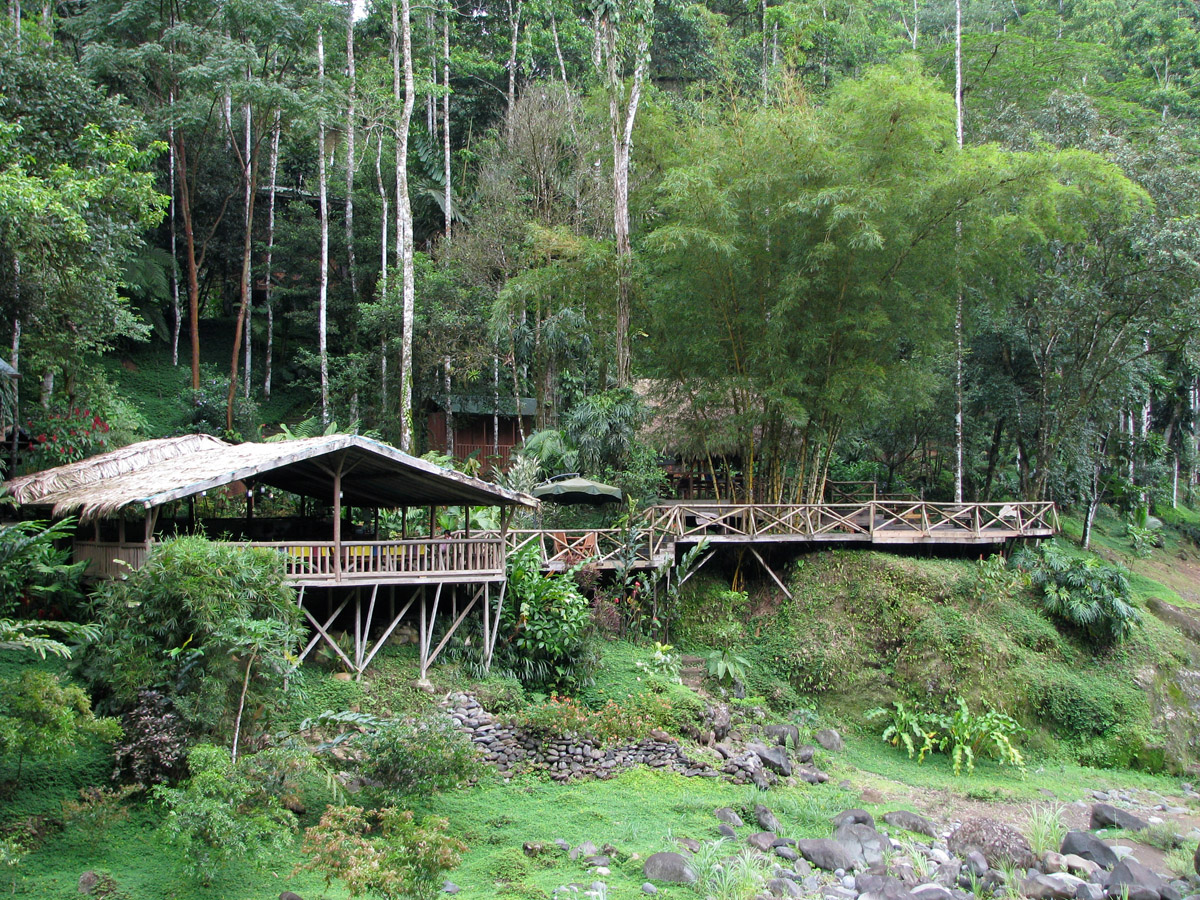
Type of accommodations
Rios Lodge operates off-grid, utilizing a mix of hydro and solar power for its energy needs. The creek’s location is ideal for generating hydroelectric power around the clock. Although Costa Rica receives about 10-12 hours of sunlight daily, solar energy operates on full efficiency for only 4-5 hours.
Cabins and cabin rooms
Rios Lodge has 11 rooms in standalone cabins and 6 in what they call the jungle tower. The accommodations include double rooms, family rooms for 3-4 guests, and one honeymoon suite, all with views of the Pacuare River or the creek running through the property.
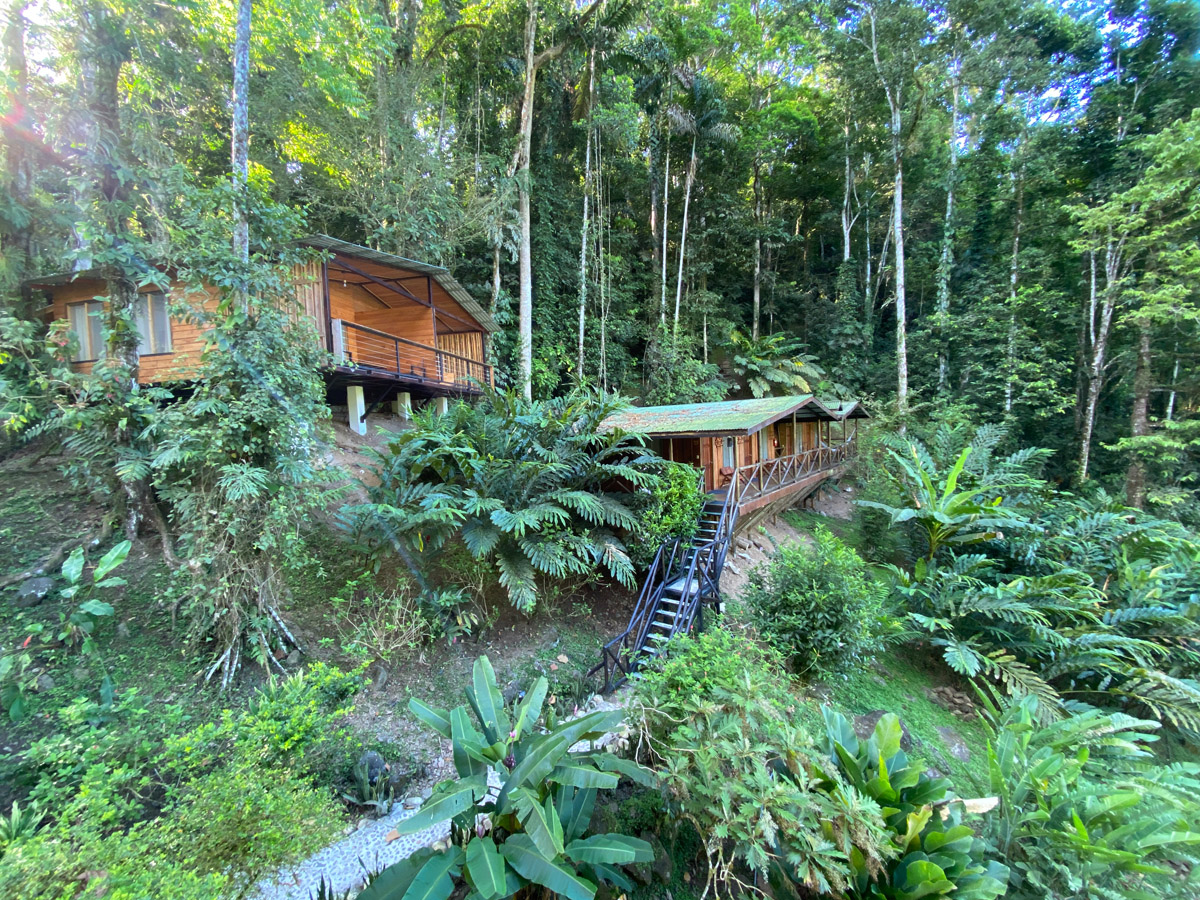
Waking up at 5 am due to jet lag, I enjoyed watching the river directly from my bed, which faced a large screened window, or from the hammock on my terrace. Each morning, I saw sparkling blue butterflies and listened to birds chirping. I observed Montezuma oropendolas busily constructing their nests and listened to the distant calls of howler monkeys. But mainly, I was captivated by the sunrise as its rays illuminated the rainforest across the river in a golden glow.

Why screen windows? The humidity is palpable here. You feel it on your skin, on the bed sheets, and on your clothes. Being too enclosed would have been suffocating. The night breeze through the screens was precisely what we needed.
The bathroom had a curtained view, and while no one could see me, I opted to keep it closed. The whole cabin was simple, cozy, and just perfect.
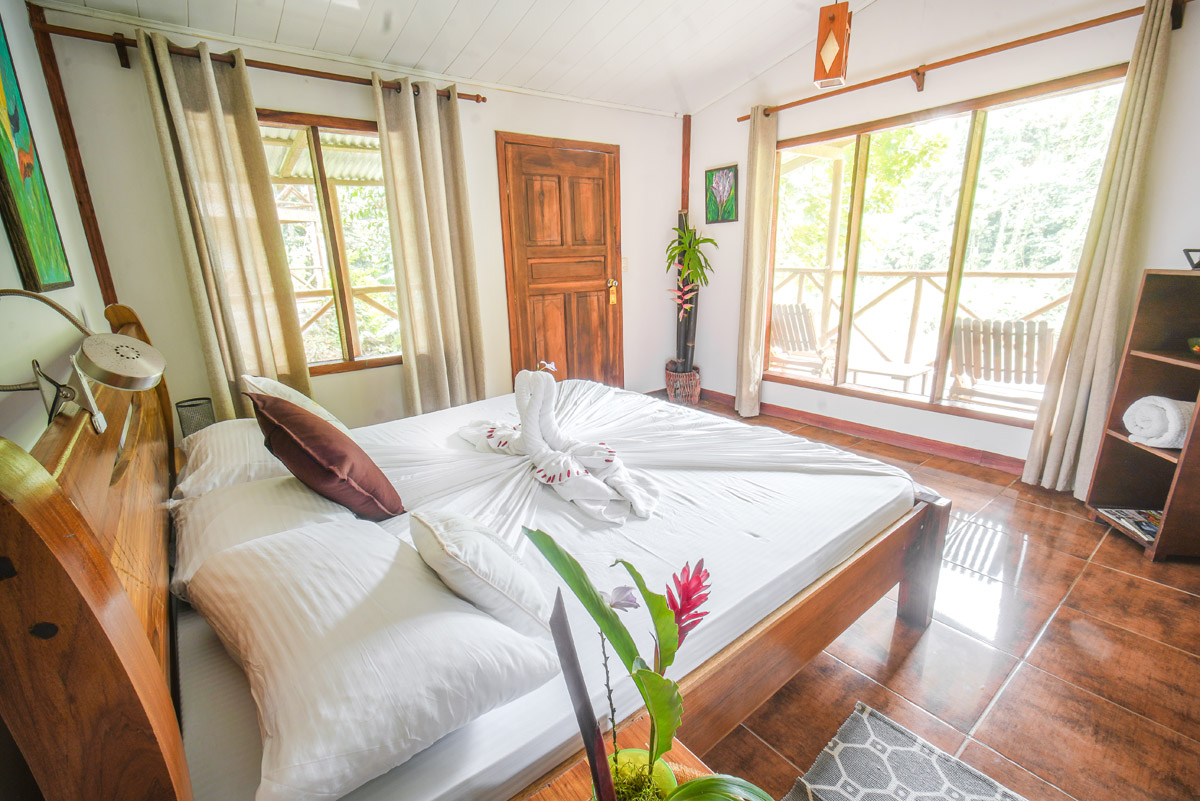
Hostel rooms
A recent addition to Rios Lodge is hostel-style accommodation. This building features eight rooms, each with four bunk beds and shared bathrooms, catering to backpackers and solo travelers. It is designed with a large terrace and a communal space equipped with multi-person hammocks.
They used wood and other sustainable building materials they had at hand. “Every piece of metal is treasure. Every single thing has a story. Everything you see was here to be re-used or bought here by rafts,” says Arturo Oropeza, one of the stewards of Rios Lodge, about the expansion.
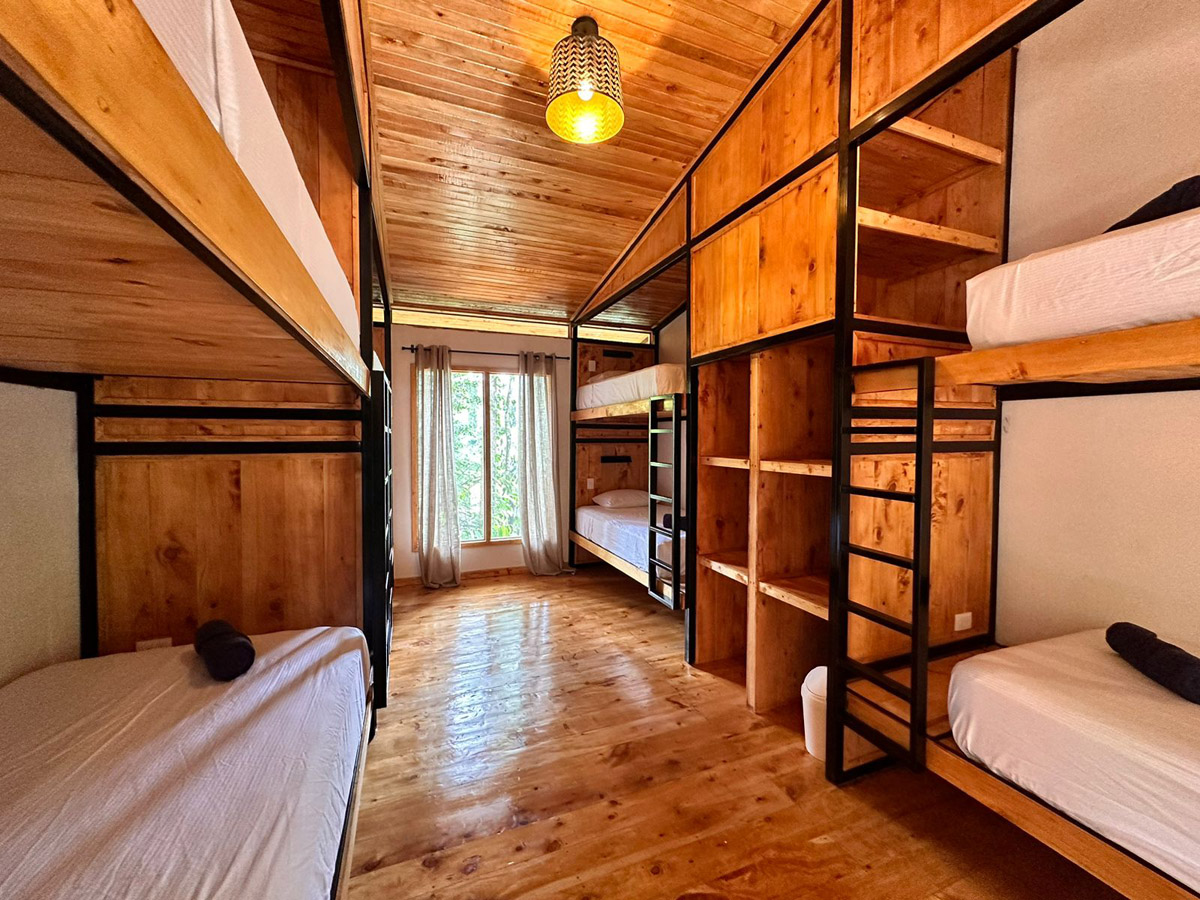
Food
Rios Lodge features an open kitchen, allowing guests to observe Chef Luca and his team at work. He works with locals from nearby villages and indigenous tribes, mentoring one of them to become a sous-chef. They are all exceptionally kind and always smiling, making them some of the most helpful and pleasant people you will encounter despite occasional language barriers.
Breakfast
We opted for the classic Costa Rican breakfast of rice and beans, fried plantains, scrambled eggs, and fresh vegetables. Tea, coffee, and filtered water were accessible around the clock, complemented by a large jug of freshly made fruit juice – pineapple, watermelon, or papaya – providing the perfect start to our day.

Lunch and Dinner
For lunch and dinner, we enjoyed two-course meals accompanied by another serving of a delightful fruit juice. Every meal was exceptional. We particularly enjoyed the spaghetti bolognese, the honey-glazed chicken with squash stew and rice, and the shrimp in coconut curry. However, the dish that stood out the most was the pan-fried mahi-mahi with pizzaiola sauce, served on a bed of julienne carrots and chopped chayote. See the picture of it below.

Activities on-site
Rios Lodge offers many activities and we chose the below options to try.

Zip-lining
Let’s start with zip-lining. It was undoubtedly the highlight of our visit and, in my opinion, a must-do activity here. It is the only zip-line in Costa Rica, with eight lines zigzagging above a river.
The adventure begins with the first two lines soaring over the lodge at a height of 60 feet, offering a perspective like that of a drone flying high and capturing stunning views. It was an exhilarating experience being so high, unlike anything I have experienced before.
When you think it could not get any better, the finale is a 350-foot zip-line that takes you right along the river, flying above the rapids.
I hope I can advertise it, but if you can, do it twice. I did, and it was so worth it. You can see my zip-lining adventures on Instagram, which I saved under Highlights.

Canyoning
I was hesitant about canyoning and nearly removed it from my list of activities, but I am happy I tried it. It was a first for me. I appreciated that it involved a gentle creek rather than daunting rapids and large pools with high rocks to jump from.
We put on our river sandals and followed the creek upstream. Our guide, Jorge, described it as a family-friendly activity especially popular with children. Though we have been far from being kids for years, we found immense joy in canyoning, barely noticing the hour we spent.

This experience also showcased our guide’s expertise and deep knowledge of the area. He recalled spotting a venomous Eyelash Pitviper on a branch ten days earlier. With a 5-foot-long wooden stick in hand, he searched for it and found the viper almost in the same place. There it was, lying lazily, seemingly undisturbed by the presence of three towering figures observing it.

As we neared the end of our adventure, our guide pointed out a termite nest on a rock and asked us, “Do you want to try it? They are peppery but tasty.” We politely declined and felt perfectly content without sampling this unique Costa Rican delicacy.
The only activity we missed was the water slide, which is not recommended during low water levels. Instead of the termite snack, that is definitely on my list for next time.
Tubing
Tubing marked another first for us. As I told you, we are not typically the adventurous type besides hiking. However, by then, our complete trust in our guide made us believers in our own capabilities. He assured me that, despite my doubts, I could paddle across the river’s calm section with my short arms. He convinced me that the low water level made it more of a child’s playground than a challenge.
It turned out he was right. Again. We put on our river sandals (a must-have in this region) and carried our inflatable rubber rings (aka tubes) down the river.
Remarkably, I managed to paddle across without needing any rescue. Eventually, I floated down an easy, rapid three times, never falling out of my tube. I don’t consider the moment I got stuck between two rocks significant since I freed myself without help. It just added to my story to tell.
It was easy, fun, and kid-friendly. I am glad I tried it on a Class I rapid, not a higher one though. This way was more fun than fear.

Night walk
Experiencing a night walk in a lodge surrounded by a well-kept garden contrasts sharply with one nestled within a dense primary rainforest. And this latter was the case at Rios Lodge. The difference was that it was more lively. Every step there was a new insect to identify.
During our walk, we observed bullet ants, army ants, leaf-cutting ants, various species of lizards, frogs, caterpillars, and spiders. We discovered that crickets in the jungle can be surprisingly loud and that moths frequently collide with us, attracted by our flashlights.
However, the highlight was seeing an ogre-faced spider. Unlike others who wait in their webs, this fascinating creature creates a net in the shape of a window. Then, the spider skillfully throws it over unsuspecting insects to capture them.
Thankfully, we did not see any snakes or giant tarantulas, although some people were rooting for them to make a quick appearance.

Best time to visit
Choosing the best time to visit Costa Rica may be tricky as the country has four distinct climates. The Caribbean coast and the area around the Pacuare River are tropical rainforests.
In this region, the dry season runs from mid-December to mid-April. This period can bring heat and humidity, yet the dense rainforest canopy provides a natural shelter. Venturing out from underneath is typically reserved for trips to the river, but the cool waters of the rapids and the small swimming pool and waterfall at the end of the creek offered a refreshing escape.
During our visit in February, we found the temperatures relatively moderate. We even noticed a slight drop during dusk and early morning when we needed a blanket to cover ourselves a bit more during sleeping.
However, it was warm and summery for rafting and other outdoor activities. I recommend you bring a hat, sunglasses, and sunscreen for protection.
How to get there
The nearest international airport to the Lodge is Juan Santamaría International Airport in San José. The Lodge advises booking an overnight stay in San José and having a morning pickup the following day.
A driver collected us from our San José hotel downtown and took us on a roughly 1.5-hour journey to Turrialba. There, we dropped off some of our luggage at the tour company, White Water Excitement. After that, it was another 45-minute drive to the river’s entry point near Siquirres. The rafting lasted around two hours arriving just in time for lunch. You can read all the details in the beginning.
I added below the map with all points of interest. If you click on it, you can browse the map freely.
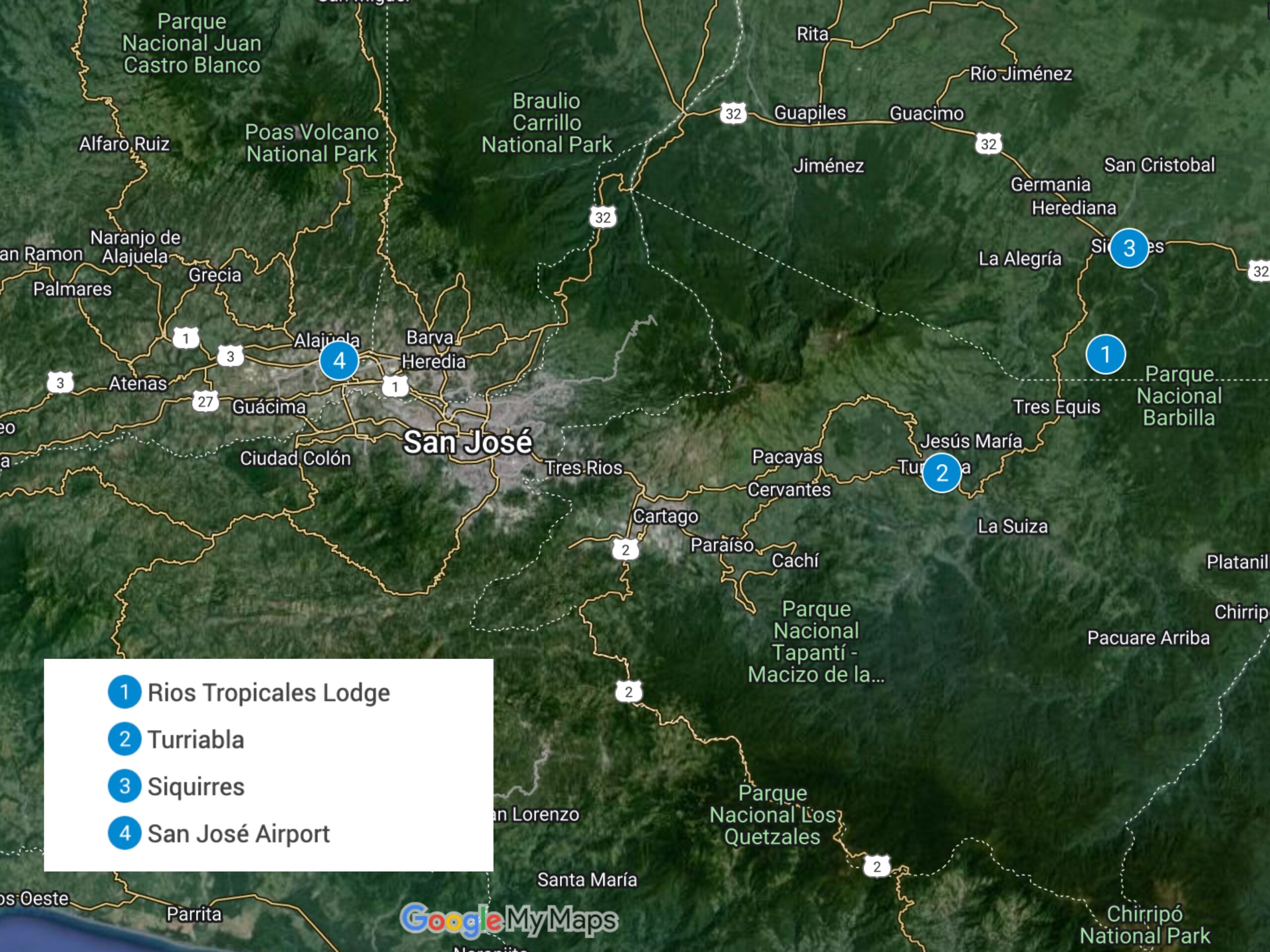
On departure, we chose to hike out. The trail, mainly following the riverbank upstream, was easy and took us about 45 minutes at a relaxed pace to reach the eco tram. This small cable car, hanging over the river, accommodates 3-4 passengers and offers a swift and fun ride. It was a charming farewell to the river.

After the tram, we took a 30-40-minute journey on a rough dirt road to the paved one. We stopped for lunch at a local restaurant, where we enjoyed superb grilled chicken marinated in coconut milk alongside a refreshing aqua de sapo, a mix of sugar cane and ginger.
Our flight was late in the evening (9 pm), so we headed straight to the airport. The Lodge generally advises you to plan your flight for the day after you hike or raft out since rafting can last 3-4 hours and traffic is often unpredictable. However, we encountered no issues or traffic, likely because we traveled on a Saturday.
Practical information
Are you sleeping with wildlife at Rios Lodge?
It is completely understandable to ask whether wildlife is a concern when visiting Costa Rica for the first time. It was one of my initial questions, too.
The cabins were clean and cozy. Despite only having screened windows, we encountered only a few ants and two tiny millipedes. Our visit coincided with the dry season, sparing us from mosquito bites. The wildlife did prefer to stay outdoors.
Throughout our time in Costa Rica, we found that wildlife was indifferent to us as long as we did not bother them. Sticking to the trails and being mindful of where we stepped or placed our hands around the Lodge were all the safety measures we needed. I truly believe it is where you can bring kids to explore nature and feel safe.
Rafting or hiking?
You can choose hiking instead of rafting to Rios Lodge. Hiking follows the same route I described above. But rafting, believe me, was fun and easy. You will be in such competent hands that all you have to do is enjoy the ride. The first part was truly gentle and kid-friendly.
We did not choose rafting for our departure primarily because it typically requires 3-4 hours, and our flight was leaving the same day. However, after three days, I felt nearly confident enough to tackle those Class III-IV rapids, especially with the promise of such an amazing waterfall (in the photo below) to witness along the journey.

What to bring with you
In short, river sandals and quick dry clothes are a must to enjoy all kinds of water activities.
Rios Lodge provides a comprehensive FAQ section and a suggested packing list that I highly recommend following thoroughly. I assumed river sandals were only necessary for rafting, but they were essential for most activities.
Opting for rafting as your arrival method to the Lodge, you will visit a natural swimming hole within 15 minutes. It means you will be wet throughout from the start. We wore quick-dry shorts and UV-protective shirts, which proved to be a good choice.
A baseball cap easily fits under a helmet. So, we had some shade from the sun on the river. While securing your sunglasses with a strap is advised for rafting, we found it necessary only for tubing.
Given the limited amount of clothing we could bring, we only packed swimsuits, quick-dry shorts, undergarments, UV-protective or quick-dry shirts, light hiking pants, thin jumpers, and hiking boots. The high humidity meant thicker shorts and swimsuits with sponge padding didn’t dry overnight.

Summary – Final thoughts
I hope my review does justice to our experience at Rios Lodge. Staying in the middle of the jungle, strangely or not, I felt peaceful. It felt like entering another world devoid of stress, rush, noise, and crowds. It was like stepping into an alternate reality or a camp where everything outside its perimeter fades away. Nothing else is more important than being there, exploring, and enjoying yourself.
I love watching the sunrise and listening to the sounds of the rainforest and the river. Walking around the Lodge meant discovering new things at every step: a vibrant green lizard here or a neon blue butterfly there.
It was also partly a digital detox, with Wi-Fi available only in the dining area. The absence of alarm clocks, notifications, and the lure of social media meant I fully embraced and enjoyed my surroundings without distraction.
I wish I had stayed longer to participate in additional activities. For example, our guide told me about many excellent hiking trails and waterfalls. With each passing day, my confidence grew. I am now eager to find out what waterfall rappelling is all about and tackle more challenging rapids with rafting. Perhaps I could even squeeze in another zip-lining session before departing.
There is always a next time. I hope it arrives soon. I think a true indicator of how much you enjoyed your vacation is how long you miss it. And indeed, I have missed it every single day since.
Emese Maczko is a travel blogger behind Eco Lodges Anywhere. Having explored several destinations around Europe, the US, Indonesia, and Australia, and resided in Germany, the United Kingdom, and Luxembourg, Emese possesses a keen understanding of diverse cultures and an appreciation for the beauty of each destination she visits. She advocates for sustainable travel and ecotourism.


